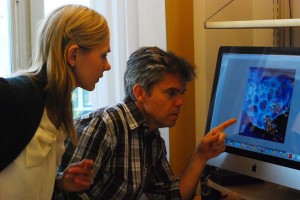
By Prof Justyna Leja
My research focuses on development of new cancer therapies, where viruses are used as a novel anti-cancer drugs.
I did my four-year PhD studies under supervision of Prof. Magnus Essand and my work resulted in the development of what is known as an adenovirus that can specifically kill neuroendocrine cancer cells.
We have published four articles where we describe various ways of controlling and modifying the virus to kill cancer cells, leaving normal cells unharmed. Paper I describes the modification of viral DNA to make it multiply to kill only neuroendocrine cancer cells.
In paper II we describe how we protect normal, non-cancerous, cells from the virus. In papers III and IV we demonstrate how we modified the virus’ surface to improve its ability to infect and spread in tumours.
Our virus has a good efficacy in killing neuroendocrine tumours (NET) in mice. Our hopes are that this treatment will have significant effects for NET patients as well. The only way to find out if our virus can help cancer patients is to perform a clinical trial and to do so we need support from public.
PAPER I
A novel chromogranin-A promoter-driven oncolytic adenovirus for midgut carcinoid therapy.
Leja J, Dzojic H, Gustafson E, Oberg K, Giandomenico V, Essand M.
Clin Cancer Res. 2007 Apr 15;13(8):2455-62.
PAPER II
Double-detargeted oncolytic adenovirus shows replication arrest in liver cells and retains neuroendocrine cell killing ability.
Leja J, Nilsson B, Yu D, Gustafson E, Akerström G, Oberg K, Giandomenico V, Essand M.
PAPER III
Adenovirus with hexon Tat-protein transduction domain modification exhibits increased therapeutic effect in experimental neuroblastoma and neuroendocrine tumors.
Yu D, Jin C, Leja J, Majdalani N, Nilsson B, Eriksson F, Essand M.
J Virol. 2011 Dec;85(24):13114-23. Epub 2011 Sep 28.
PAPER IV
Oncolytic adenovirus modified with somatostatin motifs for selective infection of neuroendocrine tumor cells.
Leja J, Yu D, Nilsson B, Gedda L, Zieba A, Hakkarainen T, Åkerström G, Öberg K, Giandomenico V, Essand M.
Gene Ther. 2011 Nov;18(11):1052-62. doi: 10.1038/gt.2011.54. Epub 2011 Apr 14.
Please also read our full FAQ
